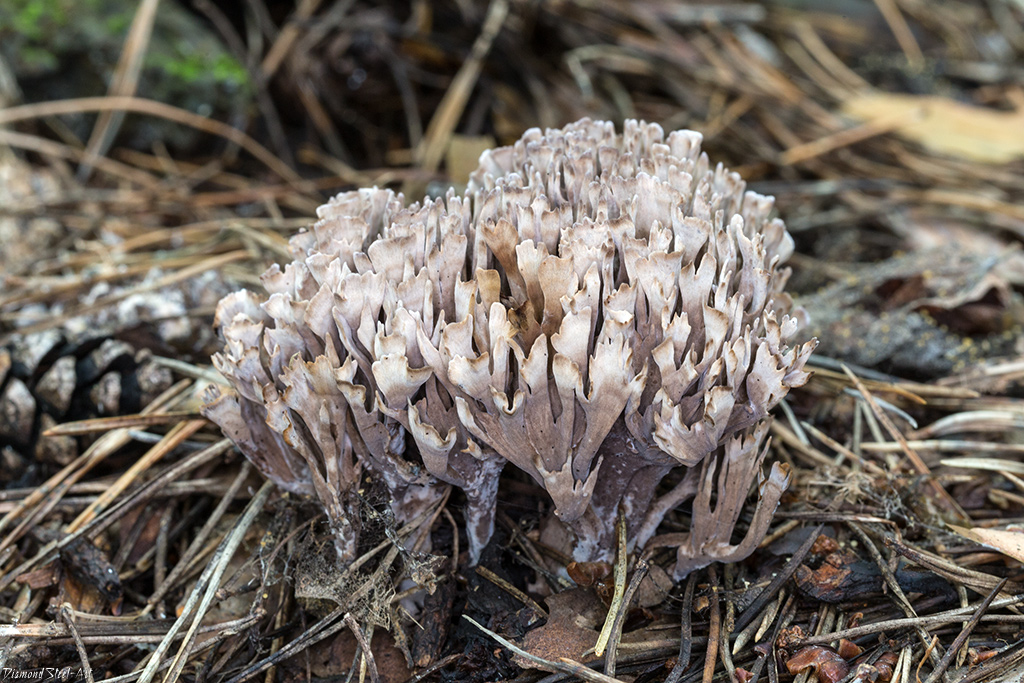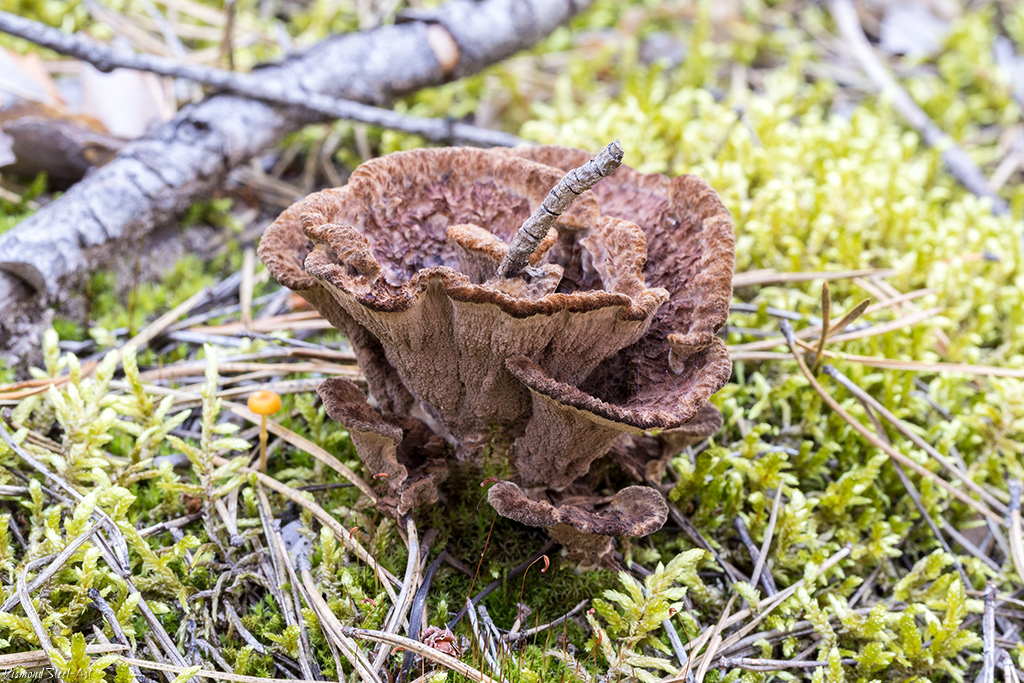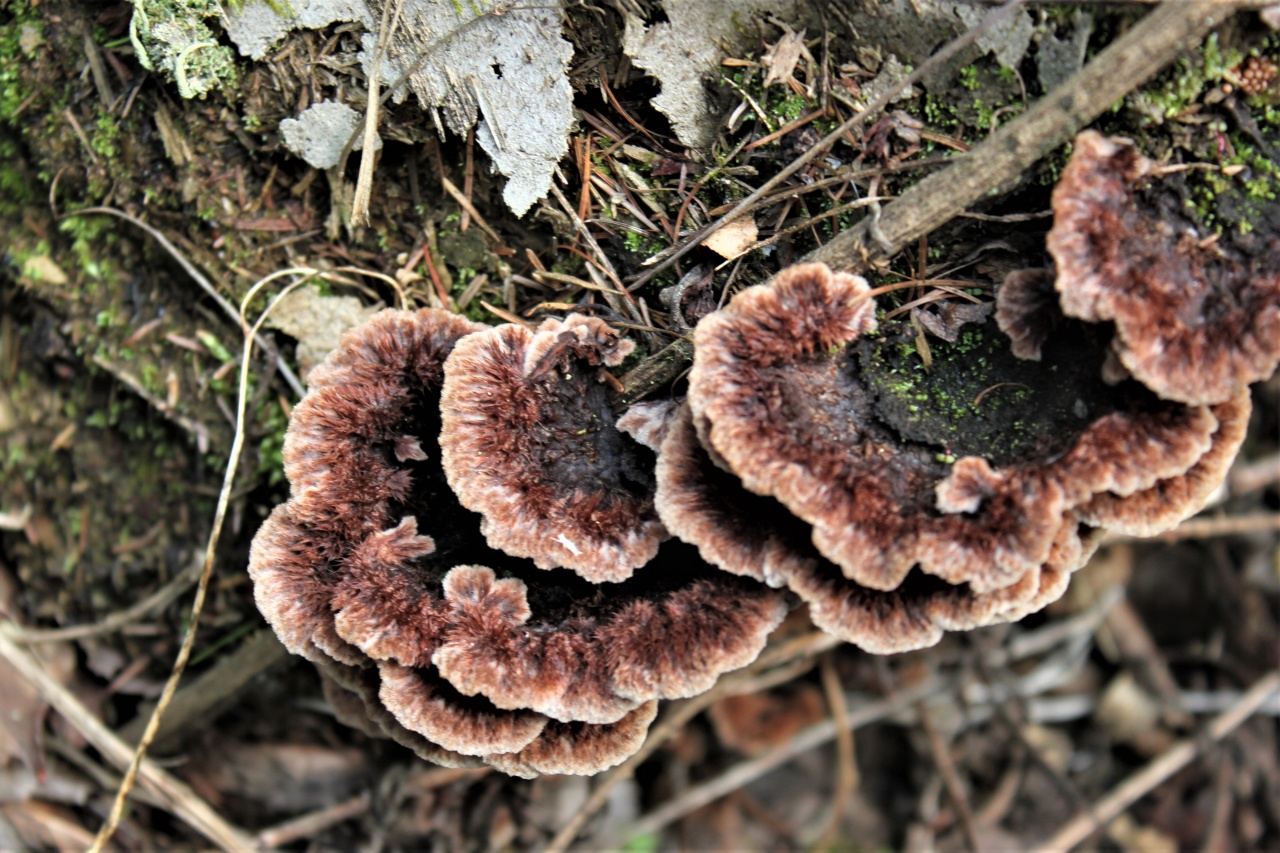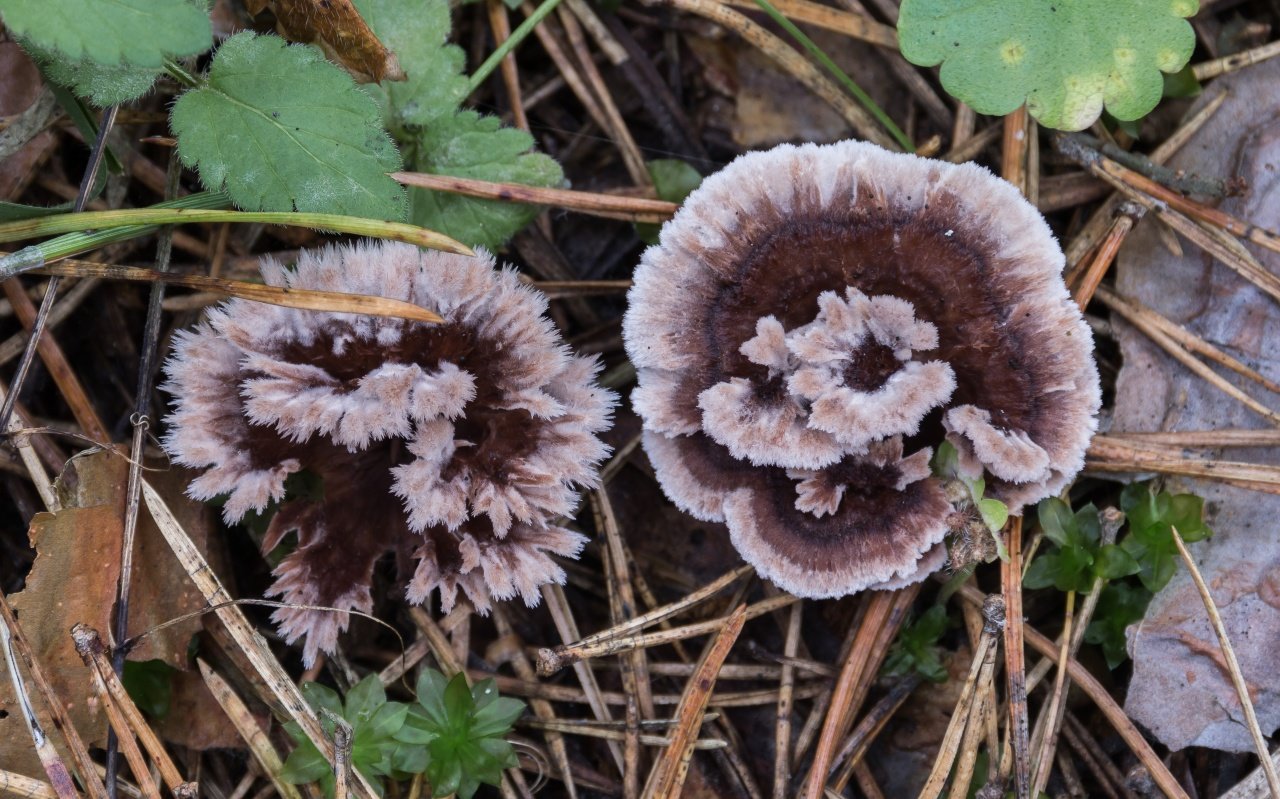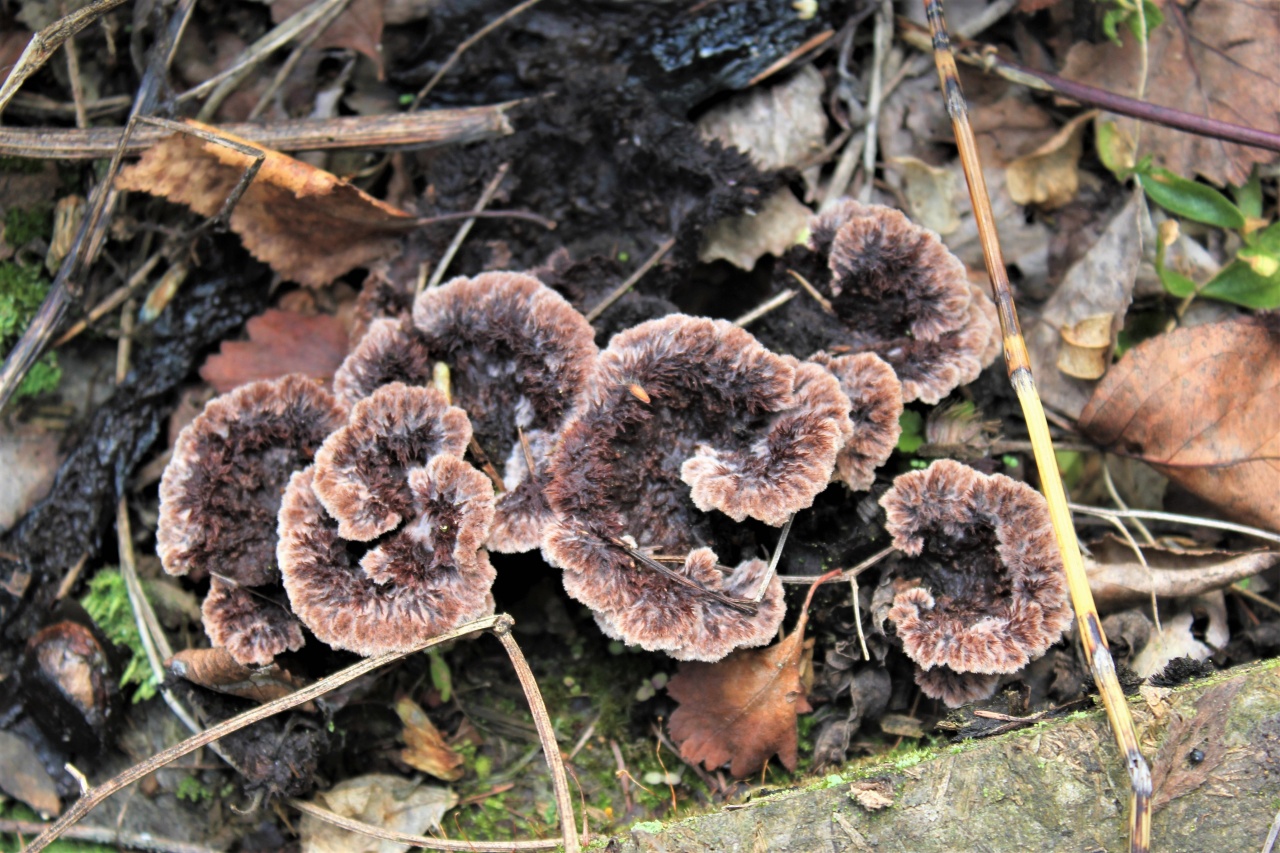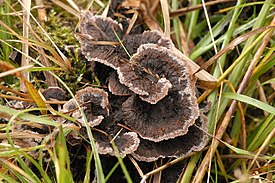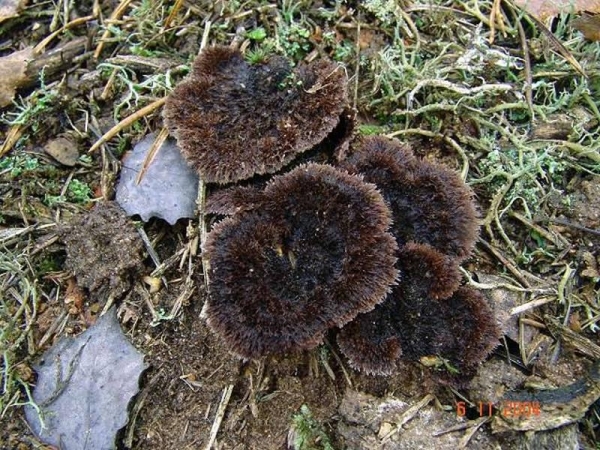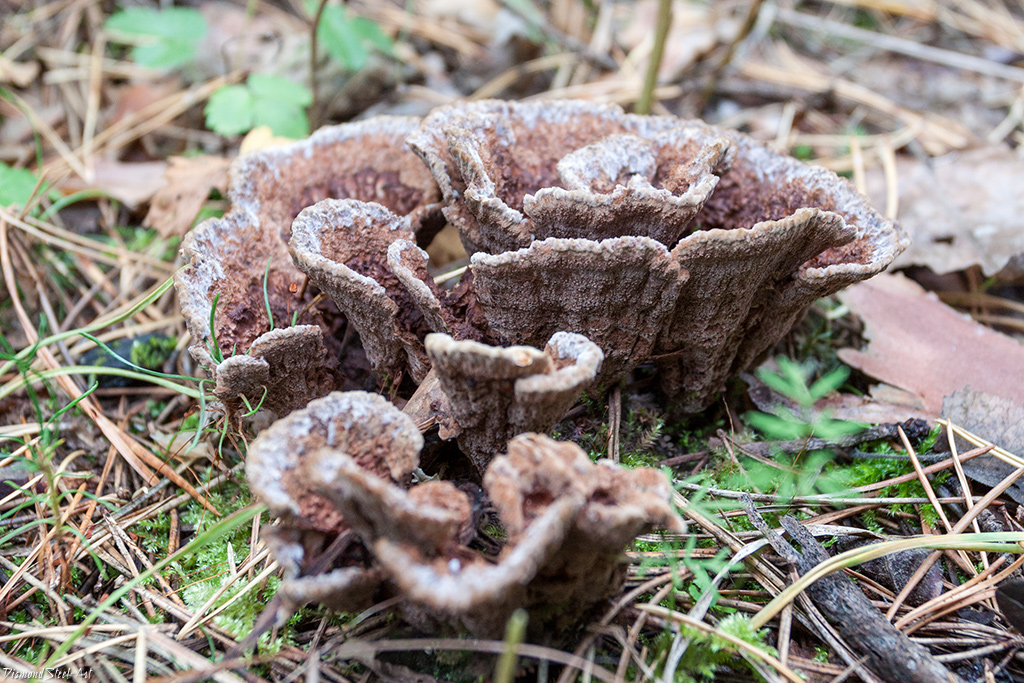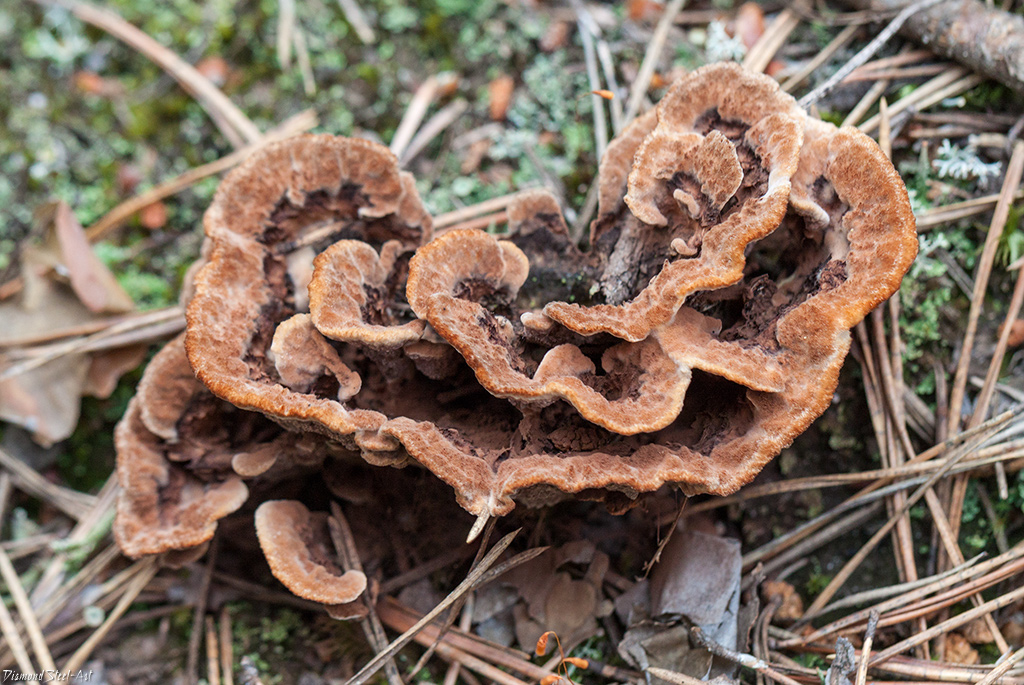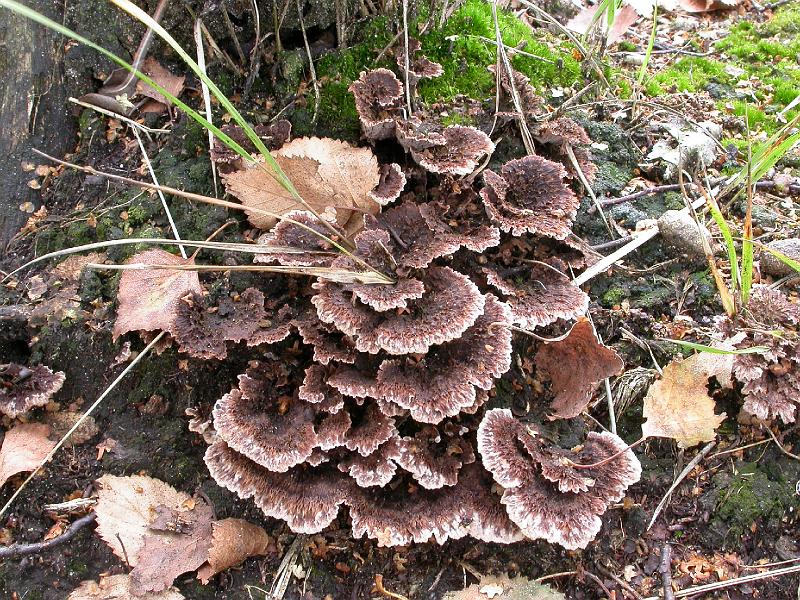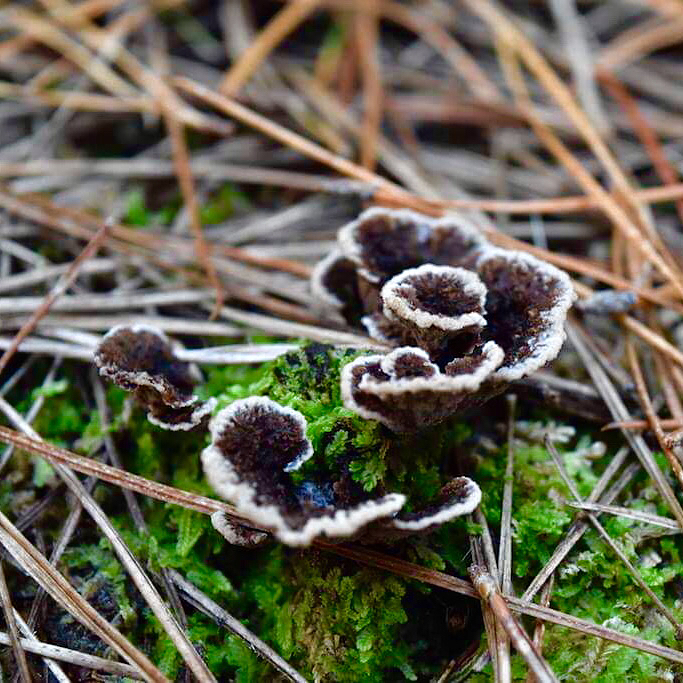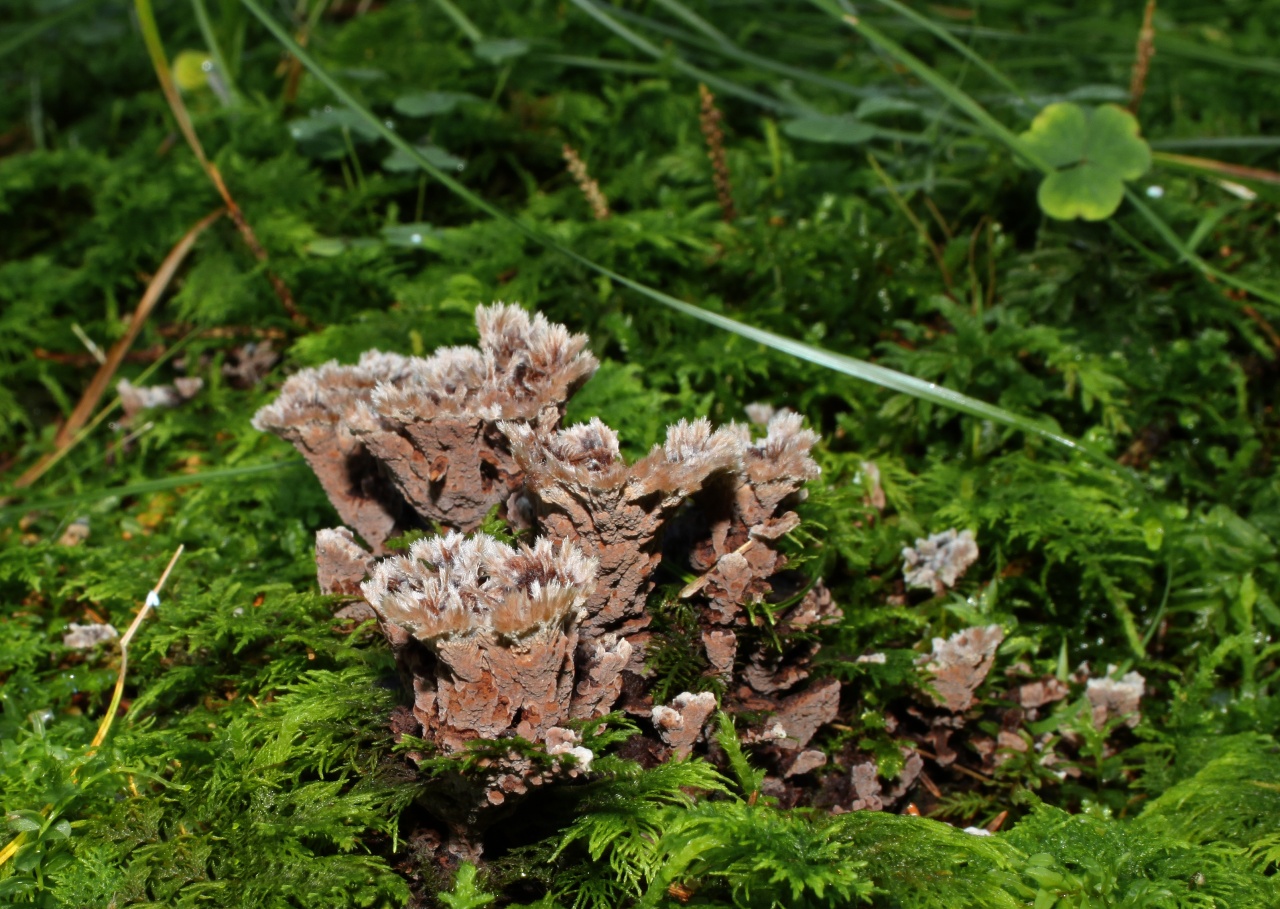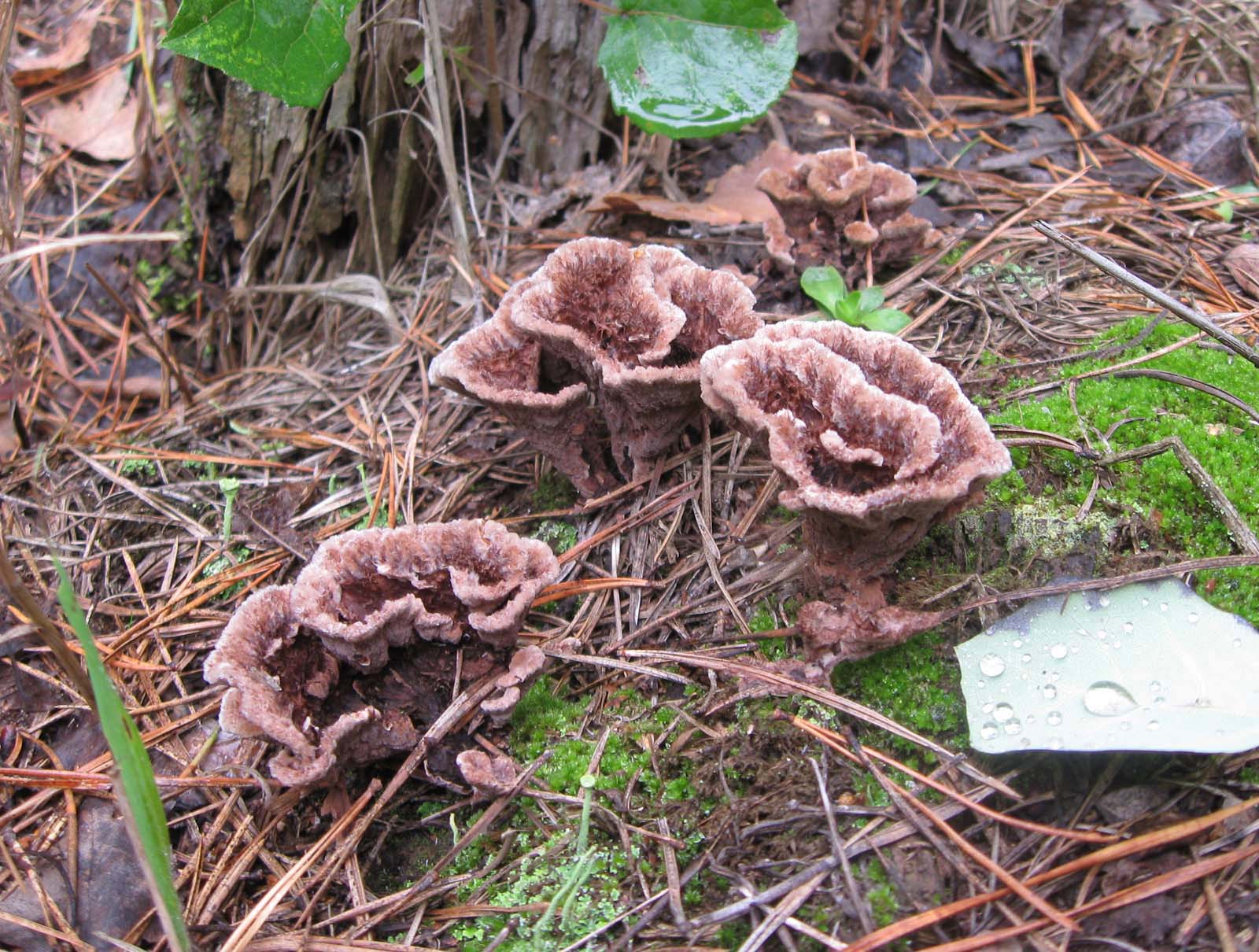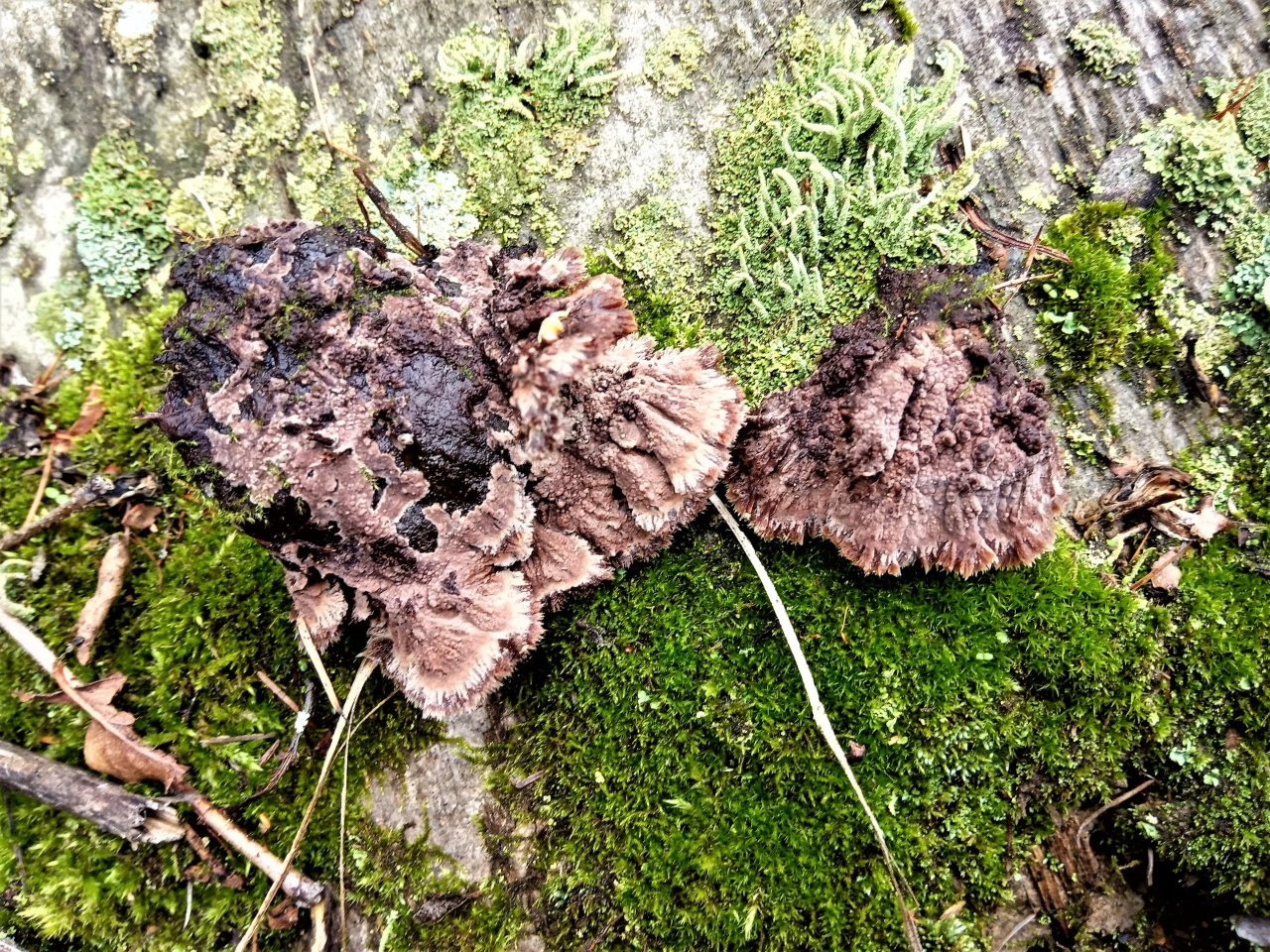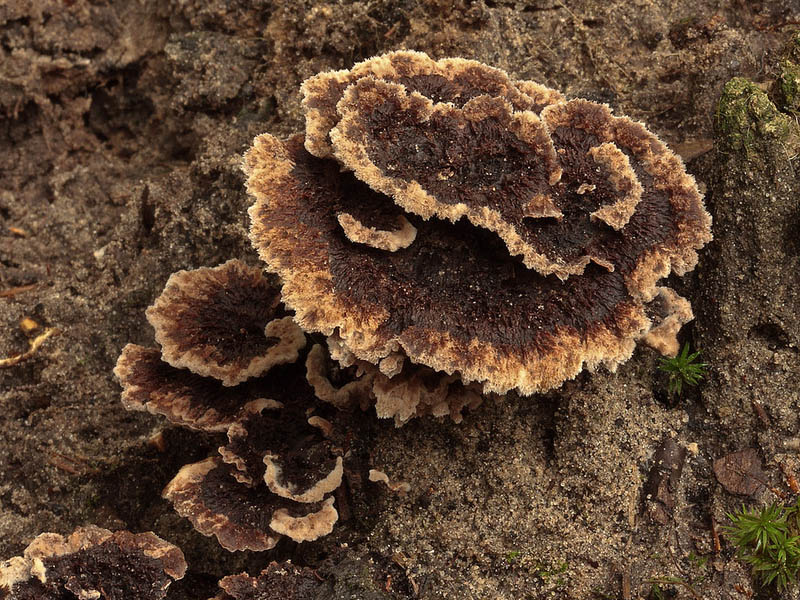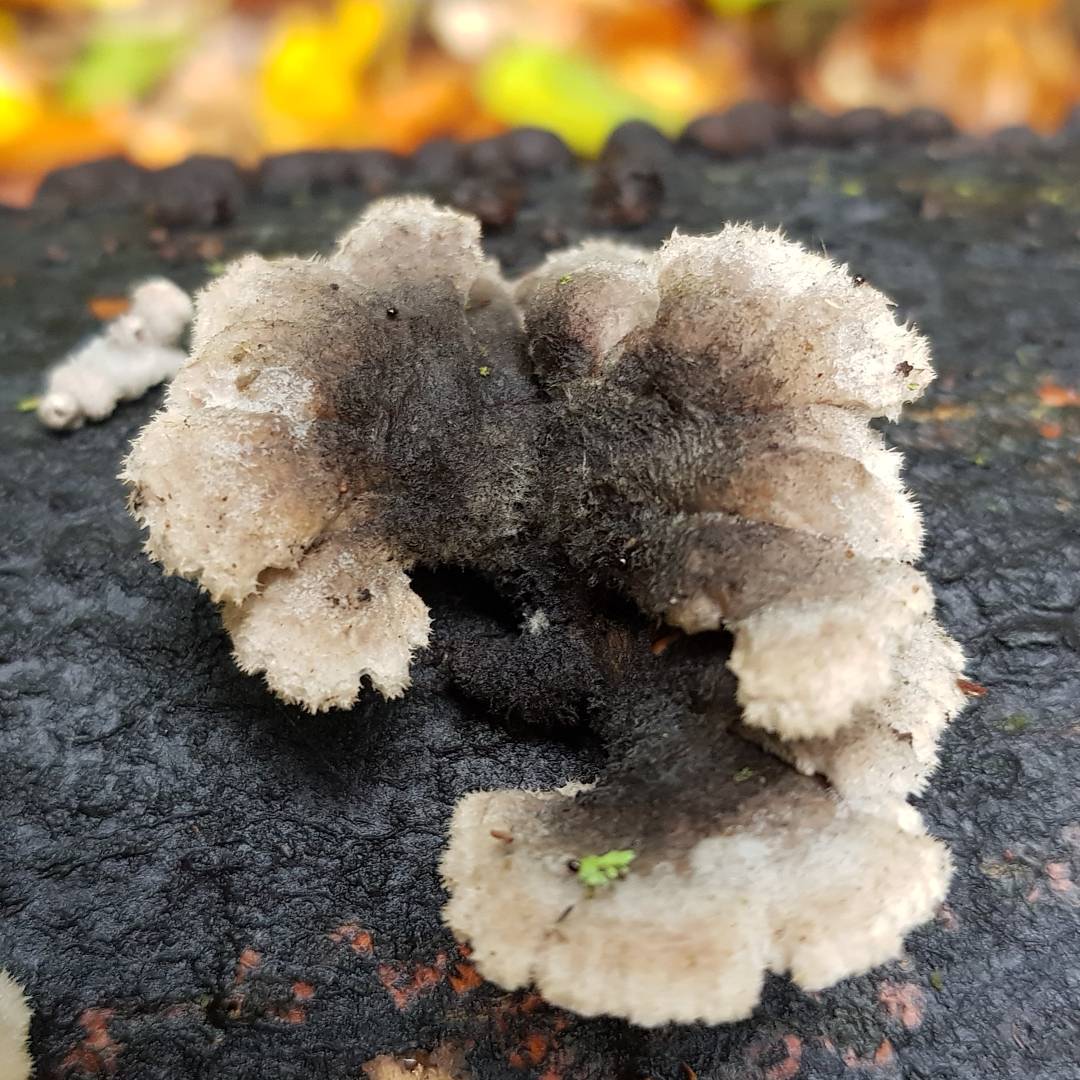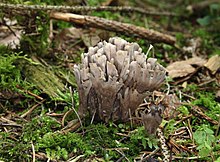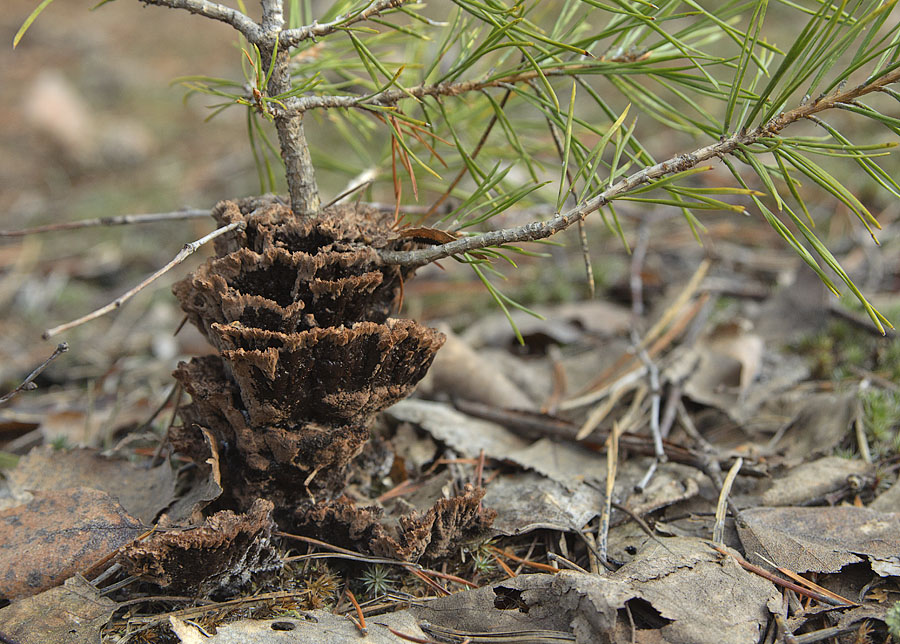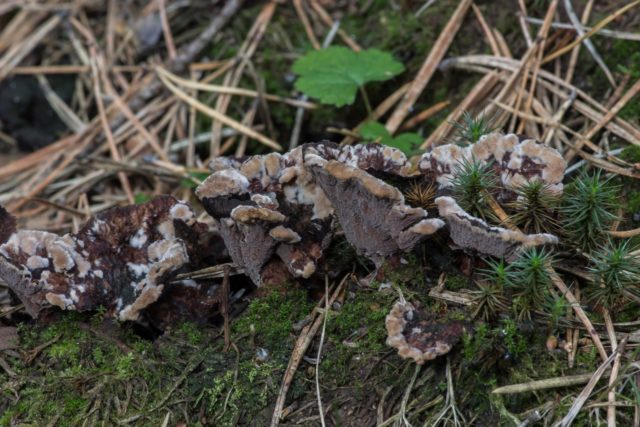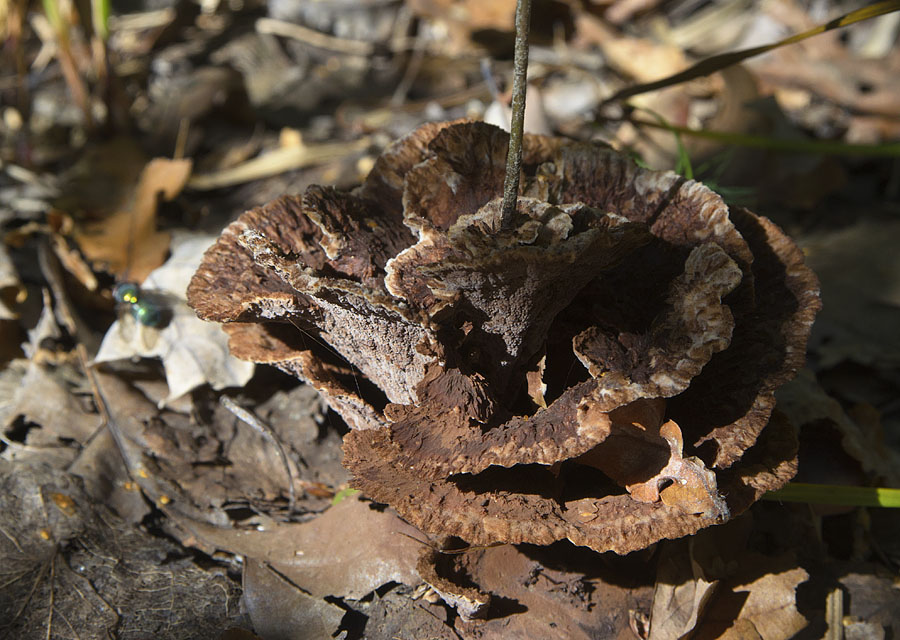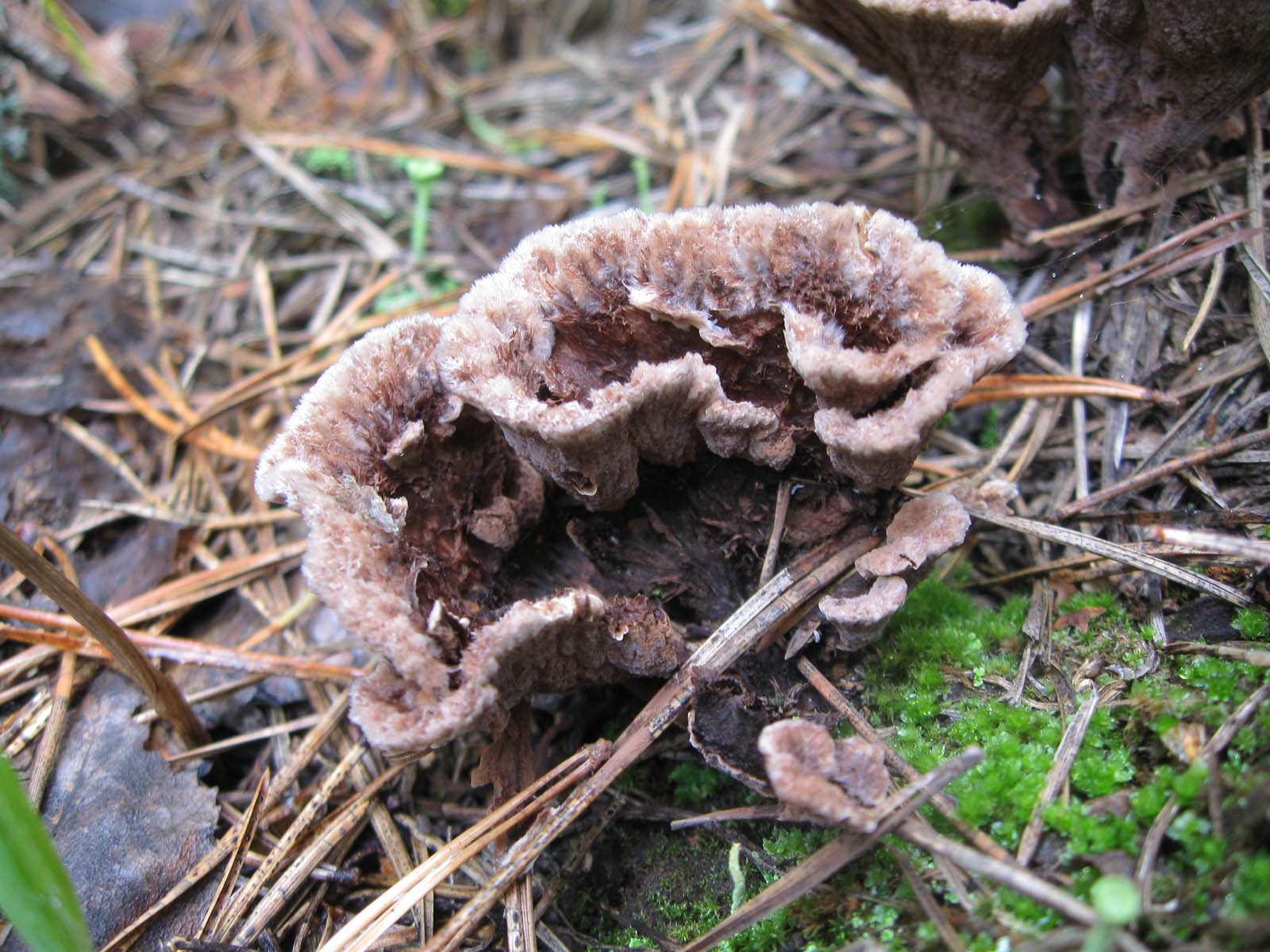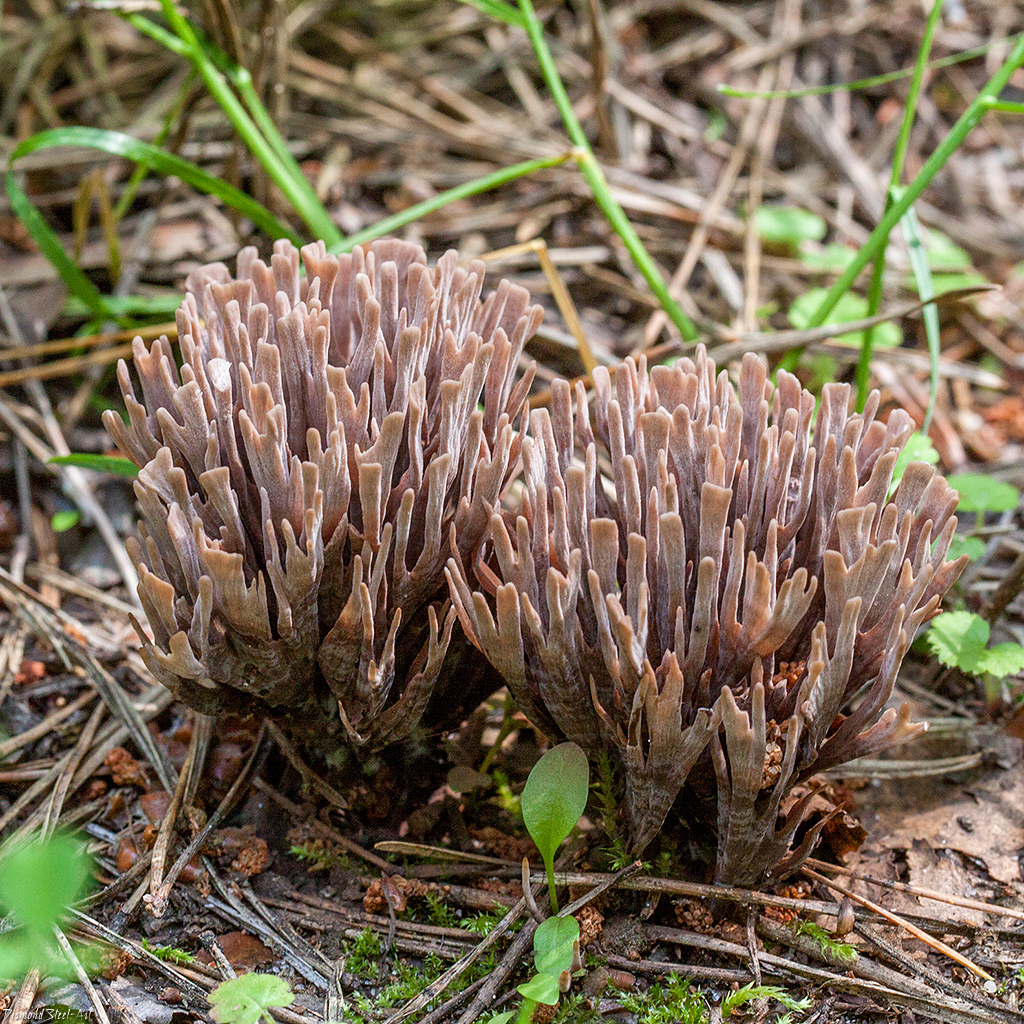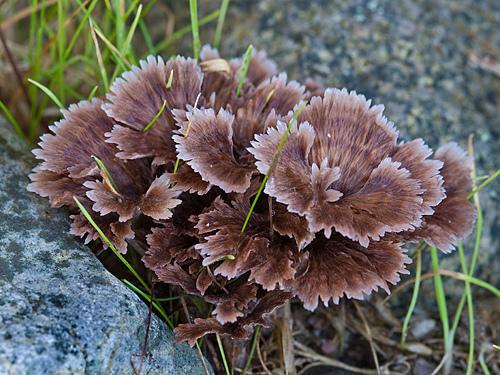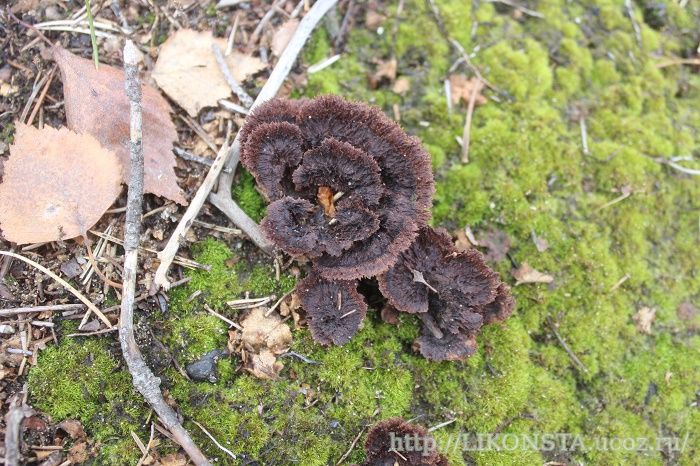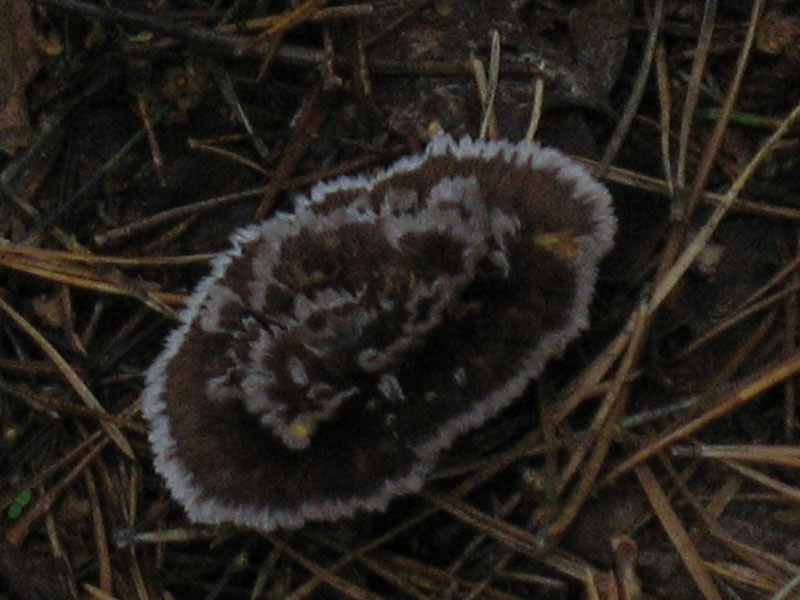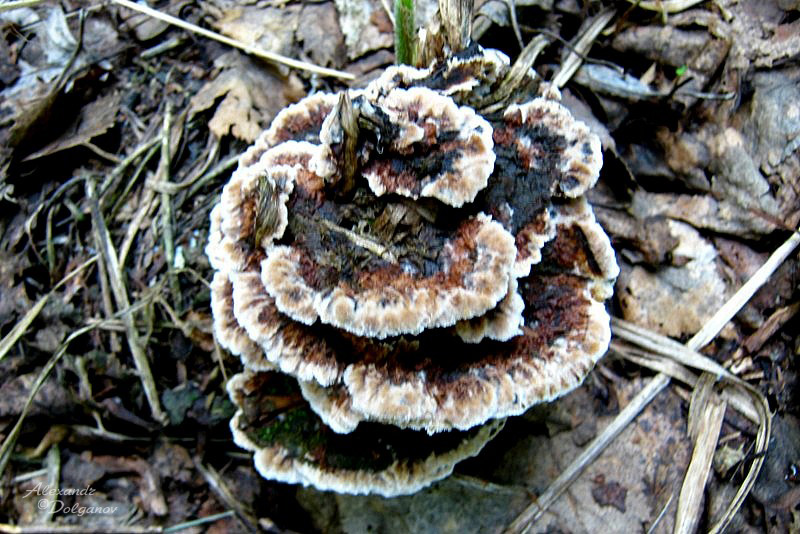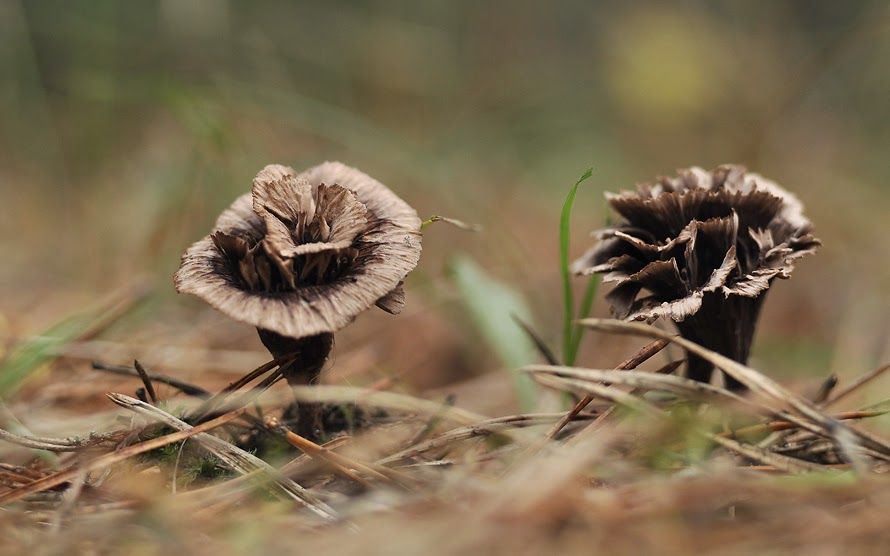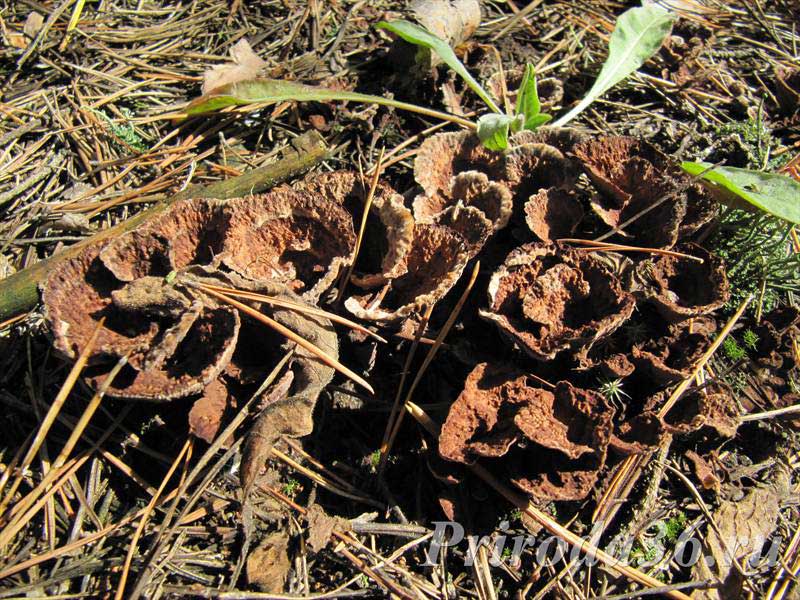Terrestrial telephony
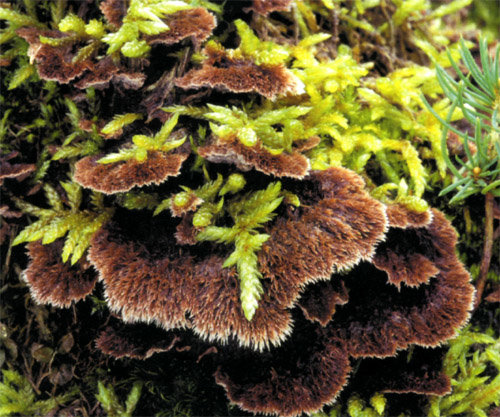
Terrestrial telephony (Thelephora terrestris)
Fruit body: The fruit body of the Telephora consists of shell-shaped, fan-shaped or rosette-shaped lobed caps, which grow together radially or in rows. The caps often form large irregular structures. Sometimes they are resupinant or prostrate-bent. The diameter of the cap is up to six centimeters. Growing together - up to 12 centimeters in diameter. At the narrowed base, the caps rise slightly, fibrous, pubescent, scaly or furrowed. Soft, concentrically zoned. Changes in color from reddish brown to dark brown. With age, the caps turn black, sometimes purple or dark red. At the edges, the cap retains a grayish or whitish color. Smooth and straight edges, later become carved and grooved. Often with small fan-shaped outgrowths. On the underside of the cap there is a hymenium, radially ribbed, warty, sometimes smooth. Hymenium is chocolate brown or reddish amber in color.
Cap: The flesh of the cap is approximately three millimeters thick, fibrous, flaky-leathery, of the same color as hymenium. It is characterized by a light earthy odor and a mild taste.
Spores: purple-brown, angular-ellipsoidal, covered with blunt spines or tuberous.
Distribution: Telefora Terrestrial, refers to saprotrophs growing on soil and symbitrophs that form mycorrhiza with coniferous tree species. It is found on sandy dry soils, in cutting areas and in forest nurseries. Despite the fact that the fungus is not a parasite, it can lead to the death of plants, enveloping the seedlings of pine and other species. Such damage, foresters call suffocation of seedlings. Fruiting from July to November. A common species in forest areas.
Edible: not consumed.
Similarity: Terrestrial Telephon, reminiscent of Telephura Clove, which is also not eaten. The Clove Telephon is characterized by a goblet shape of small fruiting bodies, a central stalk and deeply dissected edges.
Note: The fruiting body of the fungus forms next to the seedling of a pine tree or any other tree. At the same time, it can envelop the seedlings, which leads to their death. But, this mushroom is not considered a parasite, since seedlings serve as props for it. However, this fungus can cause serious damage in forest nurseries. If the fungus does not find suitable support, it forms fruiting bodies on the underside of dead branches or on small stones.
Terrestrial telephony (Thelephora terrestris) what mushrooms look like, where and how they grow, are they edible or not
Terrestrial telephony: photo and description
| Name: | Clove telephon |
| Latin name: | Thelephora caryophyllea |
| View: | Inedible |
| Synonyms: | Telephone carnation |
| Specifications: |
|
| Systematics: |
|
The terrestrial telephon belongs to non-plate mushrooms and is part of the extensive Telephor family. In Latin, its name is Thelefora terrestris. It is also known as an earthen telephor. During forest walks, you can meet her, most likely, she grows everywhere. However, it is problematic to notice it because of its appearance.
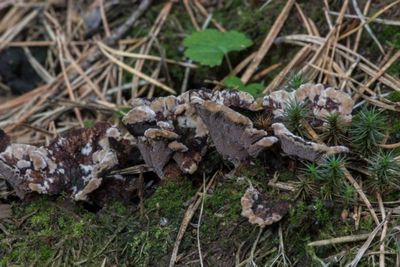
How does a terrestrial telephony look like?
The fruit bodies of the terrestrial telephora are small, no more than 6 cm in size. They look like rosettes or outgrowths. Consist of fan-shaped petals. They can be opened or collapsed. Often they merge in groups, they are open. Such aggregates can be up to 25 cm in diameter.
The shape of the fruit bodies is funnel-shaped, fan-shaped, in the form of caps attached to the side. The edges are whole or densely ciliate dissected.
Mushrooms are sessile or with a small stalk.The surface is uneven, woolly, smooth underneath. The color palette is unevenly distributed, it can vary from dark brown to brown or reddish brown. The edges are very light, brownish, tomentose.
The hymenophore is smooth or lumpy. Painted in a gray-brown shade.
Where and how it grows
Grows on soil and litter. Is an:
- saprotroph - to feed on the decomposition of organic matter;
- symbiotroph - to eat juices and secretions of the host's organism.
Forms mycorrhiza with conifers: spruce, pine, eucalyptus and other trees.
The terrestrial telephony is popular everywhere. You can meet the mushroom in deciduous, mixed and coniferous forests, in nurseries, in felling areas. He prefers dry sand soils. It can live on decaying wood, moss, needles, stumps. It grows not only singly, but also in whole groups.
The fruiting period begins in June and lasts until the end of November.
Doubles and their differences
The terrestrial telephon is very similar in appearance to another representative of the Teleforov family, the clove telephor. The difference between the latter is that its hearth bodies are smaller, have a cup-shaped, central leg. The edges are deeply dissected.
Conclusion
Terrestrial telephony, being common everywhere, is not considered edible. The pulp quickly becomes tough. Many foresters consider it to be one of the most significant fungi in nurseries. It is used for breeding conifers. Covering the roots of seedlings, it guarantees protection against fungi and bacteria, promotes the absorption of trace elements and the distribution of moisture. It helps to increase the survival rate of young trees, reduce transplant stress and accelerate growth.
Clove telephon (clove, Thelephora caryophyllea) what mushrooms look like, where and how they grow,
Clove telephon (clove): photo and description
| Name: | Clove telephon |
| Latin name: | Thelephora caryophyllea |
| View: | Inedible |
| Synonyms: | Telephone carnation |
| Specifications: |
|
| Systematics: |
|
Telephura carnation - the mushroom got its own name because of its pronounced similarity with a carnation flower. The white border around the edge of the hat looks especially great. This mushroom is able to form any clearing in the forest.
How does a clove phone look like?
In Latin, the name is Thelephora caryophyllea. The second word in translation means clove. In fact, the appearance of the mushroom strongly resembles this flower, especially if it grows alone. It can also grow in a group, then it resembles a bouquet.
The sedentary fruiting body of Telephora clove has a brown flesh, rather thin in thickness. Spores are oblong, in the form of lobules. The reproductive organs (basidia) are club-shaped, make 4 spores each.

Description of the hat
It can reach a diameter of up to five centimeters. The smooth surface is dotted with frequent streaks. The edges of the cap are torn with a bright stripe along the edge. The building resembles a fringe rolled into a spiral from a pencil sharpening or a rosette. The color palette can vary in all shades of brown, including crimson. The dried cap becomes colorless (brightens), spots appear.
Leg description
The leg can be up to 2 cm in length and up to 5 mm in diameter. It is covered with a white coating, which disappears in adulthood. The surface is smooth, matte. The structure takes into account the presence of several caps on the central leg.
Where and how it grows
Clove telephon can be found everywhere in coniferous forests throughout Eurasia. In our country, it is found from the Leningrad region to the foothills of the Tien Shan in Kazakhstan. The season begins in July and lasts until late autumn, depending on the region of growth.
Doubles and their differences
The Teleforov family has a decent number of species. The most similar are:
- Terrestrial telephony (Thelephora terrestris). The fruiting body consists of radially fused cap shells. Six-centimeter caps can grow together into one with a diameter of up to 12 cm.The surface is fibrous, with irregular edges. Has an earthy scent. Not used in food.
- Finger telephon (Thelephora palmata). It has a bushy fruiting body, somewhat similar to the hand. The finger twigs are up to 6 cm long. It has the smell of cabbage waste. It stands out with lighter and more delicate colors. Inedible.
- Multipartite telephon (Thelephora multipartita). The cap is more split into many lobes of unequal size. Growth occurs in 2 planes: horizontal and vertical. The wrinkled surface is lighter in color. The spore powder is purple in color. Inedible.
Conclusion
Clove telephon is a clear example of the diversity of nature. The plant, which is a common member of the mushroom family, looks like a flower.
Mushrooms with a smooth (or tuberous or veined) hymenophore
Most mushrooms with a smooth hymenophore have fruiting bodies in the form of sticks or branched bushes.
Hymenium covers almost the entire surface of the basidioma. At present, a significant part of such fungi, previously called horned, belongs to the order Gomphales (gomphales), the characteristics of which are given below.
Order of Gomphales (homphales)
In order, one family Gomphaceae (gomphae), which includes mushrooms with clavate or branched in the form of a bush fruit bodies. The hymenophore is smooth, covering the entire fruiting body.
Genus Ramaria (ramaria)... It unites mushrooms that look like corals, having the appearance of a bush, since the terminal branches of basidiomas branch. The color and size of basidiomas are varied. The hymenophore is smooth, characterized by an open type of development of fruiting chalk. Most of the species are saprotrophs living on the forest floor or on the decaying wood of coniferous and deciduous trees.
R. flava (yellow ramaria) is one of the largest species with fruiting bodies up to 20 cm high and 20 cm in diameter; it grows on soil in coniferous and deciduous forests. The color of the body is lemon yellow, later buffy, when pressed, it becomes blood red. Young fruiting bodies are edible. It is quite rare.
R. abietina (spruce ramaria) grows quite often under coniferous trees, sometimes forming "witch circles". Fruit bodies are buffy-brownish, turning green with age.
Genus Clavariadelphus (clavariadelphus). Combines species of mushrooms with club-shaped fruiting bodies. C. ligula (claviadelfus reed) is widespread in coniferous forests of temperate latitudes on fallen needles. Fruit bodies up to 10 cm high, firm, yellow with orange and lilac-gray tinge. Sometimes they develop in large numbers, so that the earth is like a cake with candles. Poor quality edible mushroom. In deciduous forests, a larger species, C. pistillaris (pistil claviadelfus), which has yellow basidiomas, lives on the litter.
Order of Cantharellales (cantarella, chanterelle)
The order includes mushrooms with annual fruiting bodies, soft-fleshed, in the form of branched bushes (Clavulina) or with a stem and a cap (Cantharellus, Craterellus, Hydnum). The hymenophore can be smooth, veined, or prickly.
Family Cantharellaceae (cantarellulaceae, chanterelle)
Genus Cantharellus (fox)... The edible mushroom yellow chanterelle (C. cibarius) is widely known. It is valued for the fact that basidiomas contain a large amount of vitamins (B1, PP), are not damaged by insects. Fruit bodies are yellow with a veined (folded) hymenophore. Mycorrhizal fungus.
Genus Craterellus (craterellus, gray chanterelle)... Along the paths, on the edges of deciduous and coniferous forests, there is a mushroom resembling a gray tube with a smooth hymenophore. This is an edible trumpet mushroom or gray chanterelle (C. cornucopioides), which in France is called cornucopia, and in Germany - the pipe of the dead.
Family Sparassidaceae (Sparassiaceae)
Genus Sparassis (sparassis)... S. crispa (curly sparassis) is popularly known as mushroom cabbage because it is edible. The fruit body is almost spherical, up to 35 cm in diameter, branched, with flat branches of a cream, ocher color. The hymenophore is smooth (the hymenium covers the blades with a layer). The fungus grows as a parasite on the roots of trees, is rare, included in the Red Book of Russia.
Order of Thelephorales (telephonic)
The order includes mushrooms with a spiny, smooth or lumpy hymenophore (Thelephora). The shape of the fruiting bodies varies from prostrate to cap and stalk.
Family Thelephoraceae (telephoric)
Genus Thelephora (telephone)... Telefora terrestrial (T. terestris) has fan-shaped fruit bodies, leathery, rather thin, unstratified. The surface of the cap is felt, brown shades, dissected into several flat blades. Sometimes a stem is formed in fruiting bodies. It is believed that fan-shaped fruiting bodies with negative geotropism originated from prostrate forms. The hymenophore is smooth or lumpy. A characteristic feature is the presence of tephoric acid. It grows on forest litter, buried wood, on soil in all natural zones. Found in dry and humid pine forests. Often lives along the edge of sphagnum bogs, overgrowing young pines, blueberry bushes, which leads to their suffocation and death. There is evidence that this fungus may be mycorrhizal.
Order Agaricales (agaricale), family Clavariaceae (clavarium). Genus Clavaria (clavaria). Fruit bodies are clavate or weakly branching.
If you find an error, please select a piece of text and press Ctrl + Enter.
Brush telephon (Thelephora penicillata) what mushrooms look like, where and how they grow, are they edible or not
Brush telephon: photo and description
| Name: | Brush telephon |
| Latin name: | Thelephora penicillata |
| View: | Inedible |
| Synonyms: | Merisma penicillatum, Merisma cristatum var penicillatum, Merisma fimbriatum, Thelephora cladoniiformis, Thelephora cladoniaeformis, Thelephora mollissima, Thelephora spiculosa |
| Specifications: |
|
Brush telephon is a rather rare mushroom with a cap fruit body. Belongs to the class Agaricomycetes, the Telephora family, the Telephor genus. The name in Latin is Thelephora penicillata.
How does a brush phone look like?
Thelephora penicillata has a beautiful appearance. The fruiting body is a bunch of dark fluffy tassels, lighter at the tips. Rosettes growing on stumps look much more beautiful than those growing on the ground. The latter look crumpled and trampled, although no one touches them. The color of the rosettes is violet-brown, violet, reddish-brown at the very base; in the transition to the branched ends, it is brownish. The strongly branched ends of the rosettes end in sharp spines of a whitish, creamy or cream shade.
The size of the telephony rosettes can reach 4-15 cm in width, the length of the spikes is 2-7 cm.
The flesh of the mushroom is brown, fibrous and soft.
Spores are warty, elliptical in shape, ranging in size from 7-10 x 5-7 microns. The spore powder is purplish brown.
Eat a mushroom or not
The telephon is not edible. Its flesh is thin and tasteless, with the smell of dampness, earth and anchovy. Has no gastronomic interest. The toxicity has not been confirmed.
Where and how it grows
In our country, Telefora brush is found in the middle lane (in the Leningrad, Nizhny Novgorod regions). Popular on the European mainland, Ireland, England, and also in North America.
It grows on plant remains (fallen twigs, leaves, stumps), rotten trees, soil, forest floor. It settles in wet coniferous, mixed and deciduous forests next to alder, birch, aspen, oak, spruce, linden.
Telefora brush loves acidic soils, sometimes found in areas covered with moss.
The fruiting season is from July to November.
Doubles and their differences
Tassel telephora bears similarities to Thelephora terrestris. The latter has a much darker color, loves sandy dry soils, often grows next to pines and other conifers, less often with broad-leaved species. Sometimes it can be seen next to eucalyptus trees. Occurs in felling areas and forest nurseries.
The fruit body of the fungus Thelephora terrestris has rosette, fan-shaped or shell-shaped caps that grow together radially or in rows. Large formations of complex shape are obtained from them. Their diameter will be about 6 cm, when fused, it can reach up to 12 cm. They are prostrate-bent. Their base is narrowed, the cap rises slightly from it. They have a soft structure, are fibrous, scaly, furrowed or pubescent. First of all, their edges are smooth, over time they become carved, with grooves. The color changes from the center to the edges - from red-brown to dark brown, along the edges - grayish or whitish. On the underside of the cap there is a hymenium, often warty, sometimes radially ribbed or smooth, its color is chocolate brown or amber red. The flesh of the cap has the same color as the hymenium, it is fibrous, about 3 mm thick. The aroma of the pulp is earthy.
They do not eat the telephon on the ground.
Conclusion
It is believed that the brush telephon is a saprophyte destructor, in other words, an organism that processes the dead remains of animals and plants and turns them into very simple organic and inorganic compounds, leaving no excrement. Mycologists do not yet have a consensus on whether Thelephora penicillata is considered a saprophyte or only forms mycorrhiza (fungal root) with trees.
Brush telephon (Thelephora penicillata)
Description
Fruit body: Short-lived small rosettes growing directly on the forest floor or on strongly rotted wood debris, not only on stumps, but also on fallen branches. An interesting feature: if the rosettes grow on the ground, they look rather "tortured", as if they were trampled, although in fact no one touched them. The sockets that have chosen rotten stumps for residence look much prettier. Violet, violet-brownish, reddish-brown at the base, brownish in transition to the branched tips. The tips of the rosettes are highly branched, ending in pointed spines, creamy, creamy, white on the spines themselves. Mycologists do not yet have a clear and unambiguous opinion whether the telephor is a brush fungus that forms only mycorrhiza with various living trees, or a saprophyte that feeds on dead and decaying wood debris, needles and leaves on forest soil.
Rosette dimensions: 4-15 centimeters across, individual spines 2 to 7 centimeters long.
Flesh: Soft, fibrous, brown.
Smell: does not differ, mushrooms smell of earth and dampness. There is a mention of a clearly distinguishable anchovy smell. Taste: soft, indistinguishable.
Spores: Angular ellipsoidal, 7-10 x 5-7 microns, with warts and bumps. Spore powder: Purplish brown.
Season and distribution
In coniferous and deciduous forests, from July to November. It prefers to grow in moist acidic coniferous forests, sometimes it can be found in mossy areas, not only under conifers, but also under broadleaf trees. Distributed throughout mainland Europe, including Great Britain and Ireland, registered in Russia and North America.
Edibility
No data on toxicity. The mushroom is considered inedible: there is no taste, the pulp is thin, does not represent culinary interest and does not cause a desire to experiment with the recipe.
Similar species
Terrestrial telephon (Thelephora terrestris) is much darker, most often found on dry sandy soils, especially with pines and less often under broad-leaved trees, also sometimes found with various eucalyptus trees.
Additional Information
Telephores are sometimes called "earth fans". In the UK, Telephura tassel is protected not only as a rather rare species, but also because of its uneasy relationship with some species of orchids. Yes, in good old England, orchids are appreciated. Remember, "The Dog of the Baskervilles" - "It's too early to admire the beauty of the swamps, the orchids have not bloomed yet"? So, rare saprophytic orchids, including Epipogium aphyllum, Orchid Ghost and Coralorrhiza trifida, Oralid Coralroot parasitize on the mycorrhiza formed between trees and telephors.The ghost orchid, in particular, is much less common than, for example, Thelephora penicillata.
Mushroom photo Brush telephon from questions in recognition:


